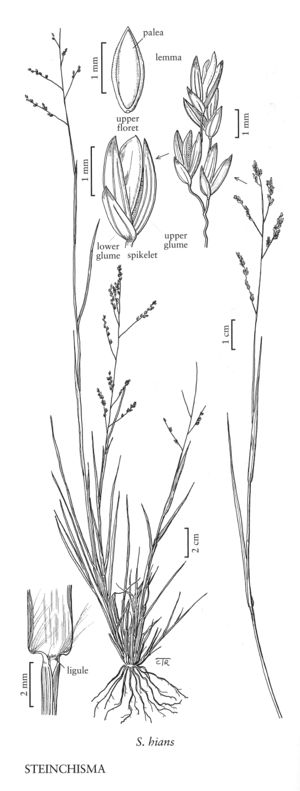| Taxon | Illustrator ⠉ | |
|---|---|---|
 | Steinchisma hians | Cindy Roché Linda A. Vorobik |
Plants perennial; cespitose, rhizomatous, rhizomes short, slender. Culms slender, often compressed. Sheaths usually keeled; ligules minute, membranous, often erose or ciliate; blades exhibiting Kranz anatomy, with few organelles in the external sheath and 5-7 isodiametric mesophyll cells between the vascular-bundles. Inflorescences terminal, open to contracted panicles; primary branches few, slender; pedicels short, to 1 mm. Spikelets ellipsoid or lanceolate, initially somewhat compressed, ultimately expanding greatly. Glumes glabrous; lower glumes 1/3 – 1/2 as long as the spikelets, usually 3 (5) -veined, acute; upper glumes and lower lemmas subequal, 3-5 (7) -veined; lower florets sterile or staminate, often standing apart from the upper florets at maturity; lower paleas longer than the lower lemmas, greatly inflated at maturity, indurate; upper florets ovoid or ellipsoid; upper lemmas usually dull-colored, minutely papillose, papillae in longitudinal rows, apices acute, x = 9 or 10.
Distribution
Va., Miss., Tex., La., Mo., N.Mex., Okla., Ala., Tenn., N.C., S.C., Ark., Ill., Ga., Fla.
Discussion
Steinchisma is a genus of 5-6 species that grow in moist or wet, usually open, sandy areas in warm-temperate and tropical regions of the Western Hemisphere. A single species is native the Flora region. It is sometimes included in Panicum, but recent studies support its recognition as a separate genus. Photosynthesis in Steinchisma is intermediate between C3 and C4 plants.
Selected References
Lower Taxa
"decumbent" is not a number.